Thirst : Water and Power in the Ancient World / / Steven Mithen.
Material type: TextPublisher: Cambridge, MA : : Harvard University Press, [2012]Copyright date: ©2012Description: 1 online resource (381 p.) : 47 color illustrations, 17 line illustrations, 1 mapsContent type:
TextPublisher: Cambridge, MA : : Harvard University Press, [2012]Copyright date: ©2012Description: 1 online resource (381 p.) : 47 color illustrations, 17 line illustrations, 1 mapsContent type: - 9780674066939
- 9780674072183
- 333.91009
- TD345
- online - DeGruyter
| Item type | Current library | Call number | URL | Status | Notes | Barcode | |
|---|---|---|---|---|---|---|---|
 eBook
eBook
|
Biblioteca "Angelicum" Pont. Univ. S.Tommaso d'Aquino Nuvola online | online - DeGruyter (Browse shelf(Opens below)) | Online access | Not for loan (Accesso limitato) | Accesso per gli utenti autorizzati / Access for authorized users | (dgr)9780674072183 |
Browsing Biblioteca "Angelicum" Pont. Univ. S.Tommaso d'Aquino shelves, Shelving location: Nuvola online Close shelf browser (Hides shelf browser)

|

|

|

|

|

|

|
||
| online - DeGruyter The Impossible Indian : Gandhi and the Temptation of Violence / | online - DeGruyter The Verdict of Battle : The Law of Victory and the Making of Modern War / | online - DeGruyter Contraception / | online - DeGruyter Thirst : Water and Power in the Ancient World / / | online - DeGruyter Aquinas on the Beginning and End of Human Life / | online - DeGruyter Native Apostles : Black and Indian Missionaries in the British Atlantic World / | online - DeGruyter Paying for the Party : How College Maintains Inequality / |
Frontmatter -- CONTENTS -- LIST OF FIGURES -- LIST OF PHOTOGRAPHS -- ACKNOWLEDGEMENTS -- 1 THIRST -- 2 THE WATER REVOLUTION -- 3 'THE BLACK FIELDS BECAME WHITE / THE BROAD PLAIN WAS CHOKED WITH SALT' -- 4 'WATER IS THE BEST THING OF ALL' - PINDAR OF THEBES 476 BC -- 5 A WATERY PARADISE IN PETRA -- 6 BUILDING RIVERS AND TAKING BATHS -- 7 A MILLION MEN WITH TEASPOONS -- 8 THE HYDRAULIC CITY -- 9 ALMOST A CIVILISATION -- 10 LIFE AND DEATH OF THE WATER LILY MONSTER -- 11 WATER POETRY IN THE SACRED VALLEY -- 12 AN UNQUENCHED THIRST -- NOTES -- BIBLIOGRAPHY -- INDEX
restricted access online access with authorization star
http://purl.org/coar/access_right/c_16ec
Water is an endangered resource, imperiled by population growth, mega-urbanization, and climate change. Scientists project that by 2050, freshwater shortages will affect 75 percent of the global population. Steven Mithen puts our current crisis in historical context by exploring 10,000 years of humankind's management of water. Thirst offers cautionary tales of civilizations defeated by the challenges of water control, as well as inspirational stories about how technological ingenuity has sustained communities in hostile environments. As in his acclaimed, genre-defying After the Ice and The Singing Neanderthals, Mithen blends archaeology, current science, and ancient literature to give us a rich new picture of how our ancestors lived. Since the Neolithic Revolution, people have recognized water as a commodity and source of economic power and have manipulated its flow. History abounds with examples of ambitious water management projects and hydraulic engineering-from the Sumerians, whose mastery of canal building and irrigation led to their status as the first civilization, to the Nabataeans, who created a watery paradise in the desert city of Petra, to the Khmer, who built a massive inland sea at Angkor, visible from space. As we search for modern solutions to today's water crises, from the American Southwest to China, Mithen also looks for lessons in the past. He suggests that we follow one of the most unheeded pieces of advice to come down from ancient times. In the words of Li Bing, whose waterworks have irrigated the Sichuan Basin since 256 bc, "Work with nature, not against it."
Mode of access: Internet via World Wide Web.
In English.
Description based on online resource; title from PDF title page (publisher's Web site, viewed 18. Sep 2023)


